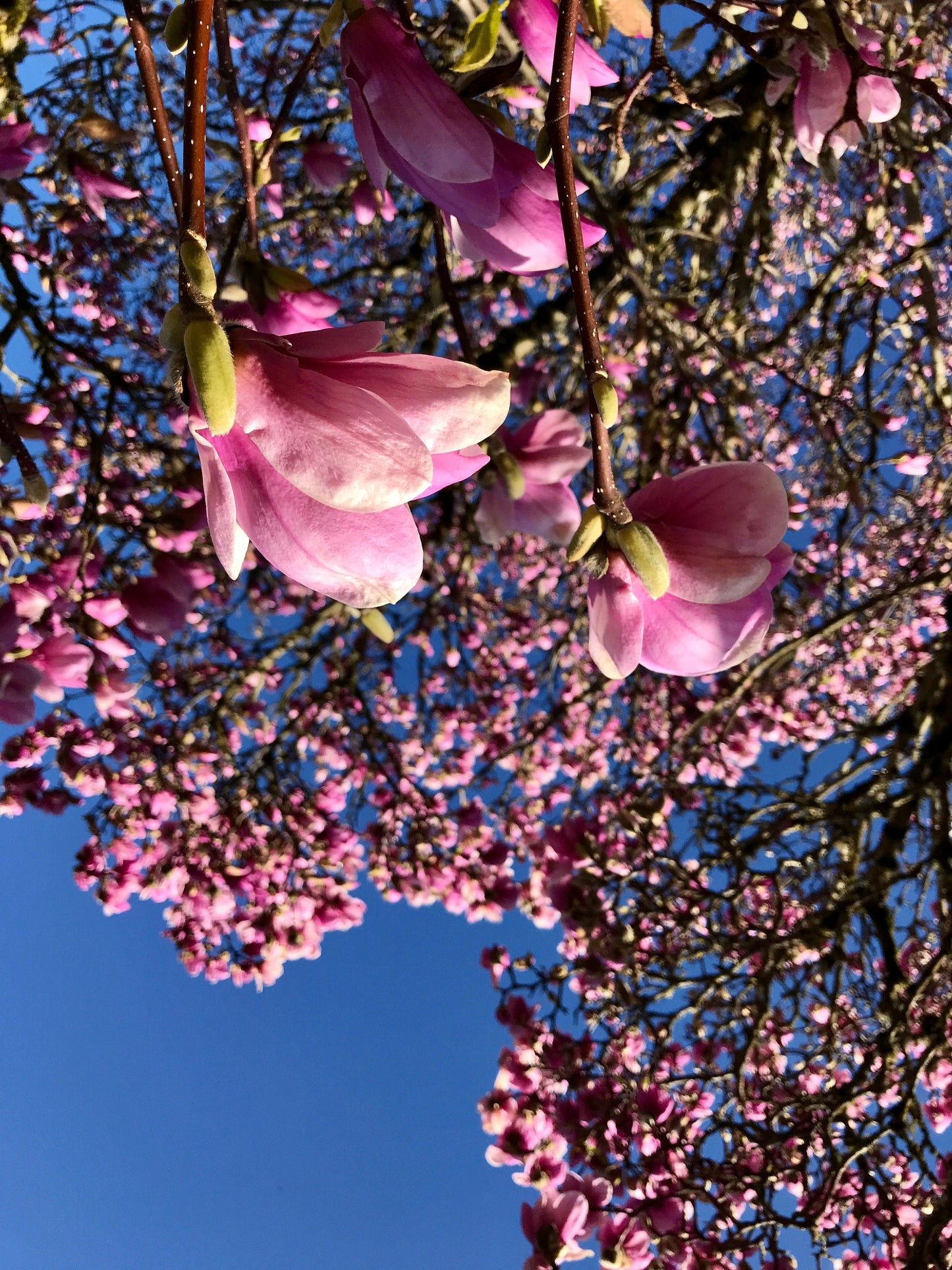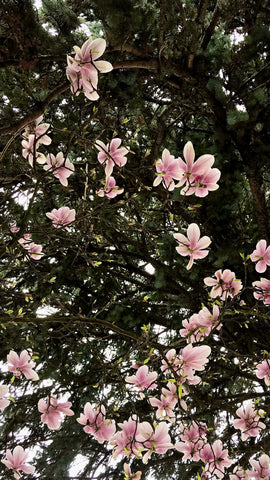

DID YOU KNOW THAT THESE GORGEOUS BLOOMS ARE EDIBLE!?
Magnolia blooms are one of our favorite wild foods to forage in the spring. It is an annual ritual that symbolizes the awakening of the Earth and the beginning of the growing and foraging seasons in the Northern Hemisphere. We love to enjoy them right off the tree, their toothy and pungent flavor opening our sinuses and senses (after all, they are medicinal too), or stuffed with nettle pesto, lightly grilled, or pickled and preserved for meals later in the summer and autumn.
The magnolia originated in Southeast Asia and North America. It is an ancient genus, appearing in the landscape even before bees! It is theorized that the flowers evolved to encourage pollination by beetles. Fossilized specimens of Magnolia acuminata have been found dating to 20 million years ago and other specimens of plants belonging to the Magnoliaceae date to 95 million years ago. The magnolia tree has been woven through centuries of folklore, culture and medicine.
They are an ancient beauty, still thriving today with over 300 flowering plant species.

The use of magnolias dates back thousands of years to Classical Chinese Medicine. Every part of the magnolia is medicinal, and its uses are far ranging from headaches to gynecological issues.
The flowers are truly aromatic, inhaling the smell will open the lungs and sinuses, clear congestion and inflammation and even reduce anxiety. We love to use the petals in teas for reducing stress and calming the mind or during cold and flu season to soothe coughs and reduce sinus pain. Enjoy the petals fresh when in season and dried for later in the year.
The petals are extremely nourishing to the skin and contain 10 times more antioxidants than Vitamin E. They can help reduce signs of aging and keep your skin moisturized. Try rubbing the fresh petals directly into your skin or infuse the dried petals into oil for a nutrient rich body and facial treatment.
Our favorite way to incorporate this ancient medicine into our lives is by eating the flowers. They are thick and fleshy, similar to a rose petal with even more bite. Their flavor is reminiscent of ginger and cardamom and they are delicious in many different types of dishes.

Here are a few recipes for you to try:
Pickled Magnolia Blossoms
1 pound magnolia petals, washed and dried if needed
1 1/2 - 2 cups rice vinegar or raw apple cider vinegar
1 tablespoon raw organic sugar (optional)
1 teaspoon sea salt (optional)
- Gently pack magnolia petals into a quart sized glass jar
- If using sugar and/or salt, stir into the vinegar until fully dissolved. The sugar and salt can be a nice addition to balance out flavors especially if you will be using your pickled petals as a substitute for pickled ginger, but not necessary to make a delicious vinegar
- Slowly pour the vinegar over the petals all the way to the top of the jar, making sure all the flowers are fully submerged. Place a piece of parchment paper over the jar before putting on the lid, this prevents the metal from rusting or use a plastic lid
- After a few weeks your pickled magnolia petals will be ready to eat. They are great in sushi, wraps, salads and bowls. We also love to use the vinegar to make salad dressings and mix with honey for a medicinal morning shot
Stuffed Magnolia Blossoms with Nettle Pesto
A dozen large whole magnolia flowers
6 cups raw nettle leaves
2/3 cup walnuts, or pine nuts, pumpkin seeds, hazelnuts, sunflower seeds
4 cloves garlic
1/3 cup finely grated Parmesan
1 tablespoon lemon juice
1/3 cup olive oil
sea salt & pepper to taste
- Be careful when handling raw nettles, they have small stinging hairs all over their leaves and stems. Some people don't mind the sting, but it can be very irritating to most. You can use gloves to remove the leaves from the stems, reserving the stems to make tea later.
- In a large saucepan, over medium high heat, add half the leaves and 2 Tbsp of water. Stir with a wooden spoon and cook until the leaves have wilted and turned dark green, about 2 minutes. Remove cooked nettle and repeat with remaining leaves. This process will remove the sting from the nettles. Drain the nettle leaves and once cooled, gently squeeze them to remove as much water as possible. Set aside.
- In a food processor or blender, coarsely chop nuts and/or seeds, garlic and Parmesan.
- Add cooked nettles, lemon juice, salt and pepper. Process until well blended.
- With the processor running, pour in olive oil to make a paste.
- Taste and adjust seasoning as desired.
- One by one, gently open your magnolia flowers and spoon pesto into the center. Close the petals back to the center. You can eat the stuffed flowers as is, or throw them on a grill for a few minutes on each side. Get creative and add your own touch. We also like to stuff the blossoms with sauteed mushrooms in addition to the nettle pesto.
A note about nettles: We love to use fresh tender nettles when they are abundant and in season in the spring. They are often referred to as nature’s multi-vitamin, packed with nutrients, and provide so many wonderful health benefits we will cover soon in another blog post. If you cannot find this super food, you can use other wild or spring greens in this recipe such as chickweed, miner’s lettuce, arugula, cress, or sorrel.
Magnolia Honey

Gently fill a glass jar with fresh magnolia petals. Pour raw honey over the petals a little at a time. Let the honey seep into all the little crevices in between the petals, making sure there are no air bubbles left in the jar. Fill the honey almost to the top, leaving a little room for possible fermentation gasses to release. Close with a lid. Every day or so turn the jar upside down letting the honey rise to the other side and back again. After two weeks you can start using your magnolia honey. We love to drizzle it over pancakes, stir a spoonful into our Women’s Sacred Sip Tea, or spread it on toast, flowers and all.
Sending out the love to you,
Jess and Team SE
*If foraging, please remember to only take one petal from each flower or a few whole blossoms from each branch and tree.
